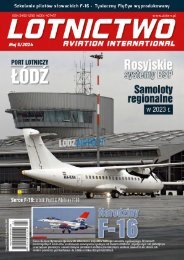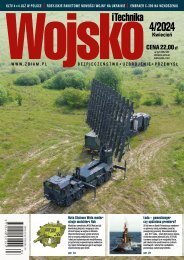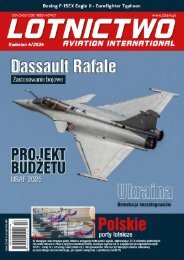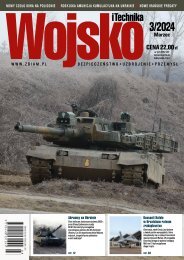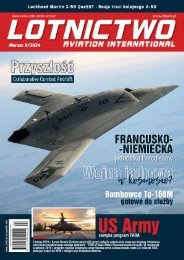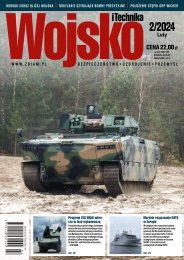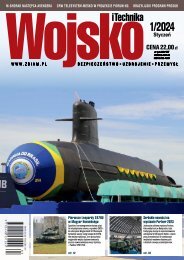Wojsko i Technika numer Specjalny MSPO 2021
by ZBiAM
by ZBiAM
- TAGS
- wwwzbiampl
- tanks
- abrams
- narew
- defence
Create successful ePaper yourself
Turn your PDF publications into a flip-book with our unique Google optimized e-Paper software.
Zbrojeniowa S.A. przygotowała projekt systemu Narew<br />
wykorzystującego w pełni polski sieciocentryczny system<br />
dowodzenia, zaproponowany przez PIT-Radwar S.A.,<br />
docelowo umożliwiający integrację z Narwią dowolnie<br />
wybranego zagranicznego rakietowego pocisku przeciwlotniczego.<br />
Jednak, MON zdecydowało, że Narew będzie<br />
wykorzystywała jako system dowodzenia amerykański<br />
system Northrop Grumman IBCS, taki sam jak zakupiony<br />
wcześniej w ramach rakietowego systemu przeciwlotniczego<br />
i przeciwrakietowego średniego zasięgu Wisła.<br />
Zgodnie z przyjętym obecnie harmonogramem programu<br />
Narew, we wrześniu miałaby zostać podpisana z konsorcjum<br />
PGZ Narew umowa ramowa, która określi sposób<br />
i zasady udzielania zamówień wykonawczych na poszczególne<br />
komponenty<br />
systemu.<br />
Następnie, w latach<br />
2022–2023,<br />
mają odbyć się<br />
negocjacje, konieczne<br />
do podpisania<br />
poszczególnych<br />
umów<br />
wykonawczych.<br />
Planowany termin<br />
dostawy<br />
pierwszego dywizjonu<br />
Narwi<br />
będzie uzależniony<br />
od możliwości<br />
produkcyjnych<br />
PGZ,<br />
czyli od tego, jak<br />
sprawnie pójdzie<br />
wdrożenie w Polsce produkcji (czy raczej początkowo<br />
montażu) wybranego pocisku rakietowego w wyniku jego<br />
transferu technologii. Według płk. Marciniaka podpisywanie<br />
wszystkich umów dotyczących programu Narew miałoby<br />
zakończyć się do 2023 r. Marciniak dodał, że „chciałby<br />
zobaczyć pierwsze elementy […] zintegrowanego systemu<br />
obrony powietrznej [czyli najwyraźniej przynajmniej<br />
jedną baterię Wisły osłanianą przez Narew – przyp. red.]<br />
w 2026 roku.” Jest to bardzo optymistyczny plan, biorąc<br />
pod uwagę tempo realizacji programu Wisła, w którym<br />
transfer technologii do polskiego przemysłu jest niewielki.<br />
special issue<br />
Wyrzutnia systemu NASAMS odpala pocisk AMRAAM-ER. Fot. Raytheon Missiles<br />
& Defense.<br />
A NASAMS launcher fires an AMRAAM-ER missile. Photo credit: Raytheon Missiles<br />
& Defense.<br />
Zadania systemu Narew<br />
Posiedzenie Komisji Obrony Narodowej 22 lipca nie dało<br />
klarownej odpowiedzi, jakie zadania ma wypełniać Narew.<br />
Teoretycznie odpowiedź jest prosta – zastąpić przestarzałe<br />
systemy rakietowe 2K12 Kub i 9K33 Osa sowieckiej produkcji<br />
w oddziałach OPL Wojsk Lądowych, a także S-125 Newa-<br />
-SC w dywizjonach rakietowych Sił Powietrznych. Jednak<br />
różni oficjele w różny sposób rozkładali akcenty. Według<br />
Ociepy Narew ma osłaniać siły lądowe i obiekty w obszarze<br />
prowadzonych działań, bazy lotnicze w ich mobilnym<br />
module osłony, uzupełniać systemy Wisła w zwalczaniu<br />
celów na małych wysokościach. Narew ma zwalczać samoloty<br />
i śmigłowce, pociski manewrujące i bezzałogowce<br />
na małych wysokościach. Natomiast wg gen. Janowskiego,<br />
appointed on May 7 a commission to prepare and conduct<br />
a public procurement procedure with Col. Marciniak appointed<br />
as its chairman for the Narew Programme. The Programme<br />
was assessed as ‘significant’ from the point of view<br />
of the basic interest of state security. It will be addressed<br />
to the PGZ Narew consortium, except for the scope related<br />
to the IBCS (Integrated Air and Missile Defense Battle Command<br />
System). Let us recall that Polska Grupa Zbrojeniowa<br />
S.A. prepared the project of the Narew system using the fully<br />
Polish network-centric C2 system, proposed by PIT-Radwar<br />
S.A., ultimately enabling the integration of any selected foreign<br />
air defence missile with the Narew system. However, the<br />
Ministry of National Defence decided that Narew would use<br />
the American Northrop Grumman IBCS system as a C2 system,<br />
the same as previously purchased<br />
medium-range Wisła defence system.<br />
According to the currently adopted<br />
schedule of the Narew Programme,<br />
in September the PGZ Narew consortium<br />
is going to sign a framework agreement<br />
which will define the way and rules for<br />
awarding contracting orders for individual<br />
components of the system. Then, in the<br />
years 2022–2023, negotiations necessary<br />
to sign individual executive agreements<br />
are to take place. The planned delivery<br />
date for the first battalion of Narew system<br />
will depend on PGZ production capabilities,<br />
i.e. production implementation<br />
efficiency of the selected missile in Poland<br />
(or rather assembly, at least initially), which<br />
is going to be manufactured in result of its<br />
technology transfer (license agreement).<br />
According to Col. Marciniak, the signing<br />
of all contracts regarding the Narew Programme would<br />
be completed by 2023. Colonel Marciniak added that ‘he<br />
would like to see the first elements […] of the integrated<br />
air defence system [Editor’s Note: that is, apparently at least<br />
one Wisła battery protected by Narew] in 2026.’ This is a very<br />
optimistic plan, taking into account the pace of implementation<br />
of the Wisła programme, with its minor transfer<br />
of technology to Polish industry.<br />
The Mission and Tasks of the Narew System<br />
The meeting of the National Defence Committee on July 22<br />
did not give a clear answer as to what tasks the Narew system<br />
is to fulfill. Theoretically, the answer is simple – to replace<br />
the outdated 2K12 Kub and 9K33 Osa missile systems<br />
of Soviet origin in the Air Defence units of the Land Forces,<br />
as well as the S-125 Newa-SC in the Air Force missile battalions.<br />
However, different officials laid out the accents differently.<br />
According to Ociepa, Narew is to cover ground forces<br />
and facilities in the area of operations, air bases as their<br />
mobile air cover module, and complement the Wisła systems<br />
in defence against low-altitude targets. Narew is to fight<br />
aircraft and helicopters, cruise missiles and unmanned<br />
aerial vehicles at low altitudes. However, according to Gen.<br />
Janowski, once an integrated air defence system is created<br />
(based on the IBCS system), perhaps the Land Forces<br />
divisions will not have to be independent in the area of air<br />
12




